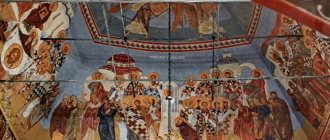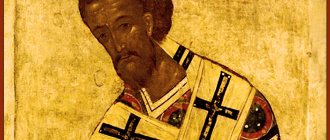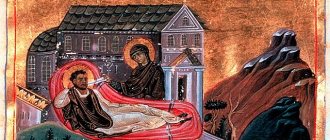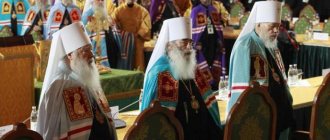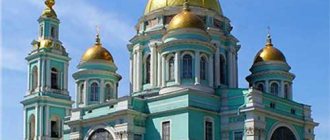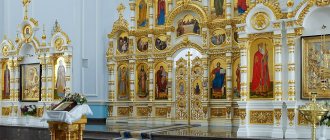| III Ecumenical Council. |
The Third Ecumenical Council
was convened in 431 in the city of Ephesus by Emperor Theodosius II the Younger. Commemoration of September 9 and the memory of the holy fathers of the six Ecumenical Councils.
- On the map: Yandex.Map, Google map (no exact coordinates)
Events preceding the Council
The council was convened against the false teaching of Archbishop Nestorius of Constantinople, who wickedly taught that the Most Holy Virgin Mary gave birth to the simple man Christ, with whom God then united morally and dwelt in Him as in a temple, just as He previously dwelt in Moses and other prophets . That is why Nestorius called the Lord Jesus Christ Himself a God-bearer, and not a God-man, and called the Most Holy Virgin Christ-bearer, and not the Mother of God (for more details, see Nestorianism).
For a certain time, this teaching was spread only as a private opinion in a circle of people involved in theological issues, and therefore it did not meet with refutations and condemnations from the Church. But Nestorius, having become the archbishop of Constantinople in 428, set out to make this teaching common to the church. The active preaching of the new teaching led to unrest in Constantinople. Nestorius began to be accused of heresy by Paul of Samosata, since it was clear that this was not only about calling the Virgin Mary the Mother of God, but about the Face of Jesus Christ. Nestorius began to persecute his opponents and even condemned them at the Council of Constantinople in 429, but in doing so he only increased the number of his enemies, of whom there were already many due to the correction he had undertaken to correct the morals of the clergy. Soon rumors of these disputes spread to other churches and discussions began here.
In Antioch and Syria, many took the side of Nestorius, mainly people who came from the Antioch School. But in Alexandria and Rome, Nestorius’ teaching met with strong opposition; it was condemned in 430 at the Councils of Rome and Alexandria.
To put an end to such discord between the leaders of famous churches and to establish Orthodox teaching, Emperor Theodosius II decided to convene an ecumenical council. Nestorius, whose side Theodosius occupied at that time, himself asked for the convening of an ecumenical council, being convinced that his teaching, as correct, would triumph.
History of the Cathedral
Theodosius appointed a council in Ephesus on the very day of Pentecost 431. St. arrived in Ephesus. Cyril of Alexandria with 40 Egyptian bishops, Juvenal of Jerusalem with Palestinian bishops, Firmus, bishop. Caesarea of Cappadocia, Flavian of Thessalonica. Nestorius also arrived with 10 bishops and two senior officials, friends of Nestorius. The first Candidian, as a representative of the emperor, the second Irenaeus - simply as being disposed towards Nestorius. Only John of Antioch and the papal legates were missing. After 16 days had passed, the period appointed by the emperor for the opening of the cathedral, Cyril decided to open the cathedral without waiting for those who were absent. The official Candidian protested against this and sent a denunciation to Constantinople.
Opening of the Cathedral. Deposition of Nestorius
The first meeting was on June 22 at the Church of the Virgin. Nestorius was invited to the council three times. But the first time he gave a vague answer, the second time he answered that he would come when all the bishops had arrived, and the third time he did not even listen to the invitation. Then the council decided to consider the case of Nestorius without him. The Nicene-Constantinopolitan symbol, letters to Nestorius, anathematisms of Cyril and letters of Nestorius to Cyril, his conversations, etc. were read.
The fathers found that the messages of Cyril contained Orthodox teaching and, on the contrary, the messages and conversations of Nestorius were non-Orthodox. Then the fathers checked how Nestorius was teaching at the present time, whether he had already abandoned his thoughts. According to the testimony of the bishops who talked with Nestorius in Ephesus, it turned out that he adhered to his previous thoughts. Finally, the sayings of the Church Fathers who wrote about the Face of the Lord Jesus Christ were read. Here, too, Nestorius contradicts them. Taking all this into account, the fathers of the Council of Ephesus recognized the teachings of Nestorius as heretical and determined to deprive him of his dignity and excommunicate him from church communion. 200 bishops signed the verdict and the first meeting ended.
On the same day, the Council of Ephesus announced the deposition of Nestorius and sent notification of this to the clergy in Constantinople. Kirill also wrote letters on his own behalf to the bishops and the abbot of the Constantinople monastery, Abba Dalmat. Soon the acts of the council were sent to the emperor. Nestorius's sentence was announced the next day after the meeting. He, of course, did not accept it and in a report to the emperor complained about the supposedly incorrect actions of the council, accused especially Cyril and Memnon and asked the emperor either to transfer the council to another place, or to give him the opportunity to return safely to Constantinople, because, in his opinion, According to him, his life is in danger.
Alternative council of supporters of Nestorius. Deposition of Cyril
Meanwhile, John I of Antioch arrived in Ephesus with 33 Syrian bishops. The fathers of the council notified him not to enter into communication with the condemned Nestorius. But John was not satisfied with the decision of the matter not in favor of Nestorius, and therefore, without entering into communication with Cyril and his council, he formed his own council with Nestorius and the visiting bishops. Several bishops who were at the Council of St. joined John. Kirill. An imperial commissioner also arrived at the Council of John. The Council of John declared the condemnation of Nestorius illegal and began the trial of Cyril, Memnon and other bishops who condemned Nestorius. Cyril was unfairly accused, among other things, that the teaching set forth in his anathematisms was similar to the wickedness of Arius, Apollinaris and Eunomius. And so, the council of John condemned and deposed Cyril and Memnon, excommunicated from church communion, until repentance, the other bishops who condemned Nestorius, reported everything to Constantinople to the emperor, clergy and people, asking the emperor to approve the deposition of Cyril and Memnon.
The Emperor is in trouble
Theodosius, who received, in addition to the reports of Cyril, Nestorius and John, also the report of Candidian, did not know what to do in this case. Finally, he ordered that all the decrees of the councils of Cyril and John be destroyed and that all the bishops who arrived in Ephesus should gather together and end the disputes in a peaceful manner. Cyril could not agree with such a proposal, since the correct decision was made at his council, and John of Antioch represented the actions of his council as correct, which both reported to Constantinople.
While this correspondence was being conducted, the council, chaired by Cyril, continued its meetings, of which there were seven. At the second meeting, the message of Pope Celestine, brought only now by the legates who had arrived, was read, and was recognized as completely Orthodox; in the third, the Roman legates signed the condemnation of Nestorius; in the fourth, Cyril and Memnon, wrongly convicted by John (who did not appear when invited to appear at the hearing) were acquitted; in the fifth, Cyril and Memnon, to refute the accusations brought against them by John, condemned the heresies of Arius, Apollinaris and Eunomius, and the council excommunicated John himself and the Syrian bishops from church communion; in the sixth - it is forbidden for the future to change anything in the Nicene-Constantinopolitan Symbol or to compose others instead; finally, in the seventh - the council took up the solution of particular issues regarding the delimitation of dioceses. All conciliar acts were sent to the emperor for approval.
Now Theodosius was in even greater difficulty than before, because the hostility between the council and the supporters of John had increased to a significant extent. And the nobleman Irenaeus, who arrived in the capital from Ephesus, acted strongly at court in favor of Nestorius. Bishop Akakios of Verria gave the emperor advice, removing Cyril, Memnon and Nestorius from the conciliar deliberations, and instructing all other bishops to reconsider Nestorius’ case. The Emperor did just that. He sent an official to Ephesus, who took Cyril, Memnon and Nestorius into custody, and began to force the other bishops to agree. But there was no agreement.
Defense of Orthodoxy by Abba Dalmat. The Emperor approves the Council's resolution
Meanwhile, St. Cyril found an opportunity from prison to write to the clergy and people of Constantinople, as well as to Abba Dalmatius, about what was happening in Ephesus. Abba Dalmatius gathered the monks of the Constantinople monasteries and, together with them, in the presence of a large crowd of people, singing psalms and burning lamps, he went to the emperor’s palace. Entering the palace, Dalmatius asked the emperor that the Orthodox fathers be released from prison and that the council's decision regarding Nestorius be approved.
The appearance of the famous Abba, who had not left his monastery for 48 years, made a strong impression on the emperor. He promised to approve the decision of the council. Then, in the church where Abba Dalmatius went with the monks, the people openly proclaimed anathema to Nestorius. Thus the emperor's hesitation ended. All that remained was to bring the Syrian bishops into agreement with the council. To do this, the emperor ordered the disputing parties to select 8 deputies and send them to Chalcedon for mutual discussions in the presence of the emperor. This delegation from the Orthodox side included two Roman legates and Bishop Juvenal of Jerusalem. On the part of Nestorius’s defenders were John of Antioch and Theodoret of Cyrus. But even in Chalcedon no agreement was reached, despite the concerns of Theodosius. The Orthodox demanded that the Syrian bishops sign the condemnation of Nestorius, but the Syrian bishops did not agree and did not want to accept, as they put it, Cyril’s dogmas (anathematisms). So the matter remained unresolved. However, Theodosius now decisively went over to the side of the Orthodox bishops. At the end of the Chalcedonian conference, he issued a decree in which he ordered all bishops to return to their sees, including Cyril, and had previously removed Nestorius to the Antioch monastery, from which he had previously been taken to the see of Constantinople. The Orthodox bishops appointed Maximilian, known for his pious life, as Nestorius' successor.
After the Council. Eastern Schism and Reconciliation 433
The eastern bishops, led by John of Antioch, departing from Chalcedon and Ephesus to their sees, along the way they formed two councils, one in Tarsus, at which they again condemned Cyril and Memnon, and the other in Antioch, at which they composed their confession of faith. In this confession it was said that the Lord Jesus Christ is a perfect God and a perfect man and that on the basis of the unity of Divinity and humanity unfused in Him, the Blessed Virgin Mary can be called the Mother of God. Thus, the Eastern fathers retreated from their Nestorian views, but did not abandon the person of Nestorius, which is why the division between them and Cyril continued. Emperor Theodosius did not lose hope of reconciling the churches and instructed his official Aristolaus to do this. But only Paul, Bishop of Emesa, managed to reconcile the Syrian and Alexandrian fathers. He convinced John of Antioch and other Syrian bishops to agree to the condemnation of Nestorius, and Cyril of Alexandria to sign the Antiochian Confession of Faith. Cyril, seeing that this confession was Orthodox, signed it, but did not renounce his anathematisms. Thus, peace was restored only in 433 [1]. The entire Ecumenical Church agreed with the Antiochian Confession of Faith, as an Orthodox one, and it received the meaning of an exact confession of faith of the ancient Orthodox teaching about the image of the union of two natures in the Lord Jesus Christ and their mutual relationship. The emperor approved this confession and made the final decision regarding Nestorius. He was exiled in 435 to an oasis in the Egyptian deserts.
Content
- 1 Participants
- 2 Council resolutions 2.1 About Maximus the Cynic (4th rule)
- 2.2 About heresies (1st rule)
- 2.3 About the Nicene-Constantinopolitan Creed (5th rule)
- 2.4 On the status of the Bishop of Constantinople (3rd rule)
- 2.5 On the autocephalous governance of local Churches (2nd rule)
- 2.6 About complaints of a private and church nature (6th rule)
- 2.7 On the form of church court and the acceptance of heretics into church communion (7th rule)
Council decisions
The council laid down eight rules. Of these, in addition to the condemnation of the Nestorian heresy, the most important is the complete prohibition not only of composing a new one, but even of supplementing or shortening, even in one word, the Symbol set forth at the first two Ecumenical Councils.
Along with the errors of Nestorius, the Pelagian heresy that appeared in the West was also condemned. The condemnation of the heresy of Pelagius was pronounced back in 418 at a local council in Carthage, and was only confirmed by the Third Ecumenical Council.
Drugs
After Constans's son and successor, Constantine IV overcame the Muslim siege of Constantinople in 678, he immediately set his sights on restoring communication with Rome: he wrote to Papa Donus suggesting a conference on the matter. When the letter reached Rome, Donus died, but his successor, Pope Agathon, agreed with the emperor's proposal and ordered councils to be held throughout the West so that the legates could present the traditions of the Western Church. There was a Synod in Milan under Archbishop Mausueta; another synod was held in 680 at Hatfield, over which Theodore, Archbishop of Canterbury, presided. Then on Easter 680, Pope Agathon convened a synod in Rome with representatives from the regional synods.
He then sent a delegation to meet the Easterners in Constantinople.[8] The delegates set off with two letters, one from Pope Agathon to the emperor, and the other from the bishops of the Synod of Rome to those assembled in Constantinople.[9]
Meanwhile, Constantine summoned Patriarch George I of Constantinople and all the bishops of his jurisdiction of Constantinople to the council. He also summoned Patriarch Macarius of Antioch, a Byzantine appointee resident in Constantinople due to the Muslim occupation of his see.
Cathedral assessments
A.V. Kartashev:
“In its external appearance, the Council of Ephesus of 431, in comparison with other ecumenical councils, is the most unseemly, vague, unsuccessful and formally simply did not take place. In its disorderliness, it is not much inferior to the neighboring Council in time and place of Ephesus in 449, which was also assembled as an ecumenical council, but was soon branded with the terrible name of “robbery.” Meanwhile, the acts of the Council of Ephesus in 449 were approved by the same emperor, Theodosius II, but the acts of the Third Ecumenical Council were not approved and the council was dissolved for disorder and lawlessness. But the church judged differently... And, as you know, Ephesus 431 was only the “beginning of illnesses.” If the Arian fever violently shook the church body for six long decades, then the intermittent fever of Christological disputes lasted for as long as 250 years, wore out the historical body of the church to the point of obvious fatigue, split and belittled the Byzantine Empire itself, carried away millions of souls from the bosom of the Catholic Church, plunging them into heresies, and took away the entire foreign outlying East from the Greek power” [2].
Background
Main article: Monotelitism
The council resolved a number of theological disputes that dated back to the sixth century but intensified under the emperors. Heraclius (r. 610–641) and Constance II (r. 641–668). Heraclius intended to regain much of his empire lost to the Persians, and tried to overcome the contradiction with Monophysitism, which was especially strong in Syria and Egypt, by proposing a moderate theological position that was as well supported in tradition as any other. The result was the first monoenergetics, i.e. that Christ, although he existed in two natures (divine and human), had one energy, and the second was monothelitism, that is, that Christ had one will (that is, in Christ there was no contradiction between his human and divine will). This doctrine was accepted in most of the Byzantine world, but was opposed in Jerusalem and Rome and caused controversy that continued even after the loss of the conquered provinces and the death of Heraclius. When Heraclius's grandson Constans II took the throne, he saw the dispute as a threat to the stability of the Empire and tried to silence the discussion by forbidding anyone to speak for or against the doctrine.[3]Pope Martin I and the monk Maximus, the main opponents of monothelitism (which they interpreted as a denial of the human capacity for the will to Christ ), synod in Rome in 649, which condemned monoenergetics and monotelism.[4] In Constantinople, about 653, some accused the Pope of supporting the revolution; this was regarded as treason, and Martin was accordingly arrested, tried, convicted and sent into exile, where he soon died. Maximus was tried and tortured to death, causing minor burns and ripping his skin apart.[5] The position of Martin and Maximus was supported by others at the Council of Constantinople.[6][7]
References
- Continuity and Change in Faith and Confession
,
Creed: A Historical-Theological Guide to Creeds and Confessions
, ed. Yaroslav Pelikan (Yale University Press, 2013), 15. - ^ a b c
George Ostrogorsky,
History of the Byzantine State
(Rutgers University Press, 1995), 127. - Acts of the Council of Chalcedon
, Volume 1, trans. Richard Price and Michael Gaddis (Liverpool University Press, 2005), 55. - Thailand, Joseph N. (2003). Saints and Feasts of the Liturgical Year
. Georgetown University Press. paragraph 60. ISBN 0-87840-399-X. - Ostrogorsky, (995), p. 117–18.
- Economou, Andrew J. (2007). Byzantine Rome and the Greek Popes: Eastern Influence on Rome and the Papacy from Gregory the Great to Zechariah, 590–752.
. Lexington Books. ISBN 978-0-7391-1977-8. - Secienski 2010, para. 74.
- ^ a b c
Joseph Brucher, S.J.,
Popes Through the Ages
Archived February 6, 2006 Wayback Machine. - Hefele, Karl Joseph von. History of Church Councils
, T. and T. Clarke, 1896, §313 - Kelly, Joseph F. "Chapter Three: Byzantine Councils." Ecumenical councils of the Catholic Church: history. Collegeville, MN: Liturgy, 2009. 59. Print.
Background
Nestorius was the Archbishop of Constantinople. His opponents accused him of dividing the divinity and humanity of Christ into two persons existing in one body, thereby denying the reality of the Incarnation. It is unclear whether Nestorius actually taught this. A combination of politics and personalities contributed to Nestorius being recognized as a heretic and deposed by the Council of Ephesus. John Anthony McGuckin sees an "innate rivalry" between the seeds of Alexandria and Constantinople.[5]
Eutyches was an archimandrite in Constantinople. In his opposition to Nestorianism he seems to have held an equally extreme, though opposite, view. In 448, Bishop Flavian of Constantinople held a synod at which Eusebius, Bishop of Dorylaeum, brought charges of heresy against Eutyches.[6] Eutyches was called upon to appear and explain his position regarding the nature of Christ. Finding his answer unsatisfactory, the synod condemned and exiled Eutyches, who sent an appeal to Pope Leo I. When Leo received the Acts of the Council, he concluded that Eutyches was a foolish old man who had committed a mistake through ignorance and could be reinstated if he repented. Dioscurus of Alexandria, imitating his predecessors in taking primacy over Constantinople, simply overturned the sentence against Flavian and acquitted Eutyches. Dioscurus and Eutyches obtained from the emperor the convening of an Ecumenical Council, which was to meet in Ephesus in August 449.
Bibliography
- Batrellos, Demetrios (2004). The Byzantine Christ: Person, Nature and Will in the Christology of Saint Maximus the Confessor
. Oxford-New York: Oxford University Press. ISBN 978-0199258642 .CS1 maint: ref = harv (link to website) - "Concilium Universale Constantinopolitanum Tertium", in Acta Conciliorum Oecumenicorum, ser. 2, II.1–2. ed. R. Riedinger (Berlin 1990 and 1992).
- Economou, Andrew J. 2007. Byzantine Rome and the Greek Popes: Eastern Influence on Rome and the Papacy from Gregory the Great to Zechariah, 590–752.
. Lexington Books. - Govorun, Kirill (2008). Will, action and freedom: Christological debates in the seventh century
. Leiden-Boston: BRILL. ISBN 978-9004166660 .CS1 maint: ref = harv (link to website) - Meyendorff, John (1989). Imperial unity and Christian division: The Church 450–680.
N. E. Church in history.
2
. Crestwood, New York: St. Vladimir's Seminary Press. ISBN 978-0-88-141056-3 .CS1 maint: ref = harv (link to website) - Ostrogorsky, Georgy. History of the Byzantine State
. New Brunswick: Rutgers University Press. ISBN 0-8135-0599-2 - Siecienski, Anthony Edward (2010). Filioque: a history of doctrinal controversy
. Oxford University Press. ISBN 9780195372045 .CS1 maint: ref = harv (link to website)
Reception
The council wrote a regular letter to the emperor (see Perry, trans., p. 431), who confirmed it with his own letter (Muncy, vii. 495, and Perry, p. 364). Dioscorus sent an encyclical to the bishops of the East with a form of accession to the council, which they were required to sign (Perry, p. 375). He also went to Constantinople and appointed Anatoly as his secretary as bishop to see this.
Juvenal of Jerusalem was faithful to Dioscorus. He overthrew the patriarchs of Antioch and Constantinople, but still one powerful enemy remained. He stopped at Nicaea and with ten bishops (probably the same ten Egyptian metropolitans whom he brought to Ephesus), “in addition to all his crimes, he spread his madness against the one to whom the Savior had entrusted the guardianship of the vine,” according to the bishops in Chalcedon," and excommunicated the Pope himself."
Meanwhile, Leo I received the appeals of Theodoret and Flavian (whose deaths he did not know) and wrote to them, as well as the Emperor and Empress, informing them that all acts of the Council were annulled. He eventually excommunicated everyone who took part in it and acquitted everyone he had condemned (including Theodoret), with the exception of Domnus of Antioch, who seems not to have wanted to return to his see and went into the monastic life, which he abandoned many times. years ago with regret.
The Council of Chalcedon gave rise to what was called the Monophysite Schism[1][2] between those who accepted the Second Council of Ephesus and those who accepted the Council of Chalcedon: many Byzantine emperors tried to reconcile the opposing sides over the next few hundred years,[1 ][3] in a process that gave rise to several other schisms and doctrines later condemned as heresies, such as monoenergetics and monotheletism, which were intended as an attempt at compromise between Chalcedonian and non-Chalcedonian parties (see Henotikon
and Three Heads - the latter itself led to another schism lasting over a century, the Three Heads Schism).[1][3]
Links
Eastern Church Trullo Cathedral | Fourth Council of Constantinople (Sophia) | Fifth Council of Constantinople | Jerusalem Cathedral | Pan-Orthodox Cathedral Western Church Fourth Council of Constantinople | First Lateran Council | Second Lateran Council | Third Lateran Council | Fourth Lateran Council | First Lyon Cathedral | Second Lyon Cathedral | Vienne Cathedral | Cathedral of Constance | Ferraro-Florence Cathedral | Fifth Lateran Council | Council of Trent | First Vatican Council | Second Vatican Council Robber Cathedrals Antioch Cathedral | Milan Cathedral | Ephesus "Robber" Cathedral | first Iconoclastic Council | Second Iconoclastic Council





